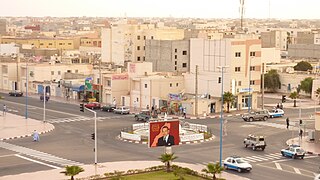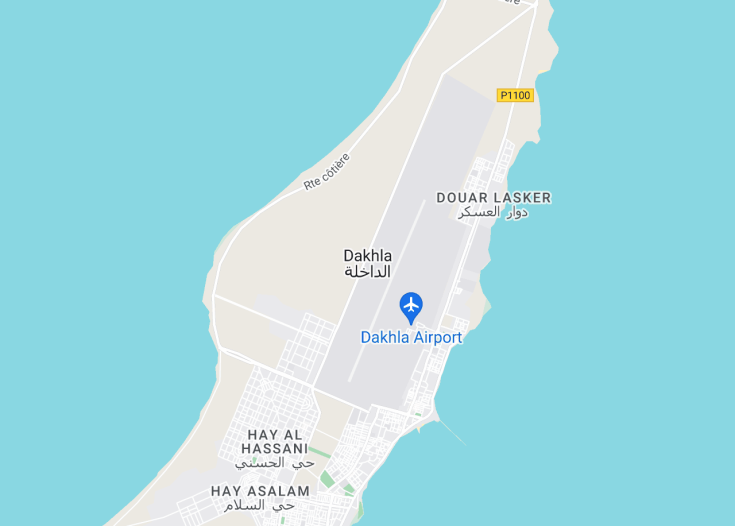Nestled on the pristine Atlantic coast of the Western Sahara, Dakhla offers a unique blend of dramatic desert landscapes and vibrant marine life. Renowned for its spectacular kite-surfing conditions and rich culture, this serene destination promises an extraordinary blend of adventure and tranquil beauty. It’s an ideal place for those who seek a reprieve from the bustling city life, looking to explore unspoiled nature.
Before visiting Dakhla, ensure to pack sunscreen, a hat, and comfortable walking shoes to fully enjoy the diverse terrains from sandy beaches to rugged cliffs.
While planning your trip, consider timing your visit during the Dakhla Festival for a unique experience of local music, food, and customs.
Top things to do & see in Dakhla
Select the following sights and activities to discover best tickets and tours available in Dakhla.
Dakhla: A Desert Oasis with a Coastal Charm
</_retainer>
| Country | Western Sahara |
| Time in Dakhla | GMT-1 |
| Language spoken | Hassaniya Arabic |
| Population | 56,000 (according to World Population Review) |
| Currency | Moroccan Dirham (MAD / MAD) |
| Airports | Dakhla Airport (3 mi / 5 km). |
Perched on a narrow peninsula in the disputed region of Western Sahara, Dakhla is unique fusion of desert landscapes and serene ocean vistas. This captivating city is ensconced between the majestic sands of the Sahara and the rugged Atlantic waves—blurring the lines between an arid desert life and a bustling Atlantic port. Dakhla offers a blend of rich history and cultural melting pot as it stands as an intersection of Berber, African, and Arabic cultures. Known for its rich marine life and coastal breezes, Dakhla is a charming destination differing notably from typical Saharan destinations.
Where is Dakhla?
Dakhla is located on a narrow peninsula on the Atlantic coast in the south of Western Sahara, approximately 560 km south of Laâyoune.
Distances:
| Route | Distance by car | Time by car |
|---|---|---|
| Laâyoune to Dakhla | 560 km | Approximately 7.5 hours |
| Nouadhibou to Dakhla | 470 km | Approximately 6 hours |
What is Dakhla famous for?
Dakhla is renowned for its kitesurfing and windsurfing due to its optimal wind conditions year-round. The city also offers enchanting desert tours, fishing trips, and its annual music festival drawing both local and international visitors.
History
Prehistoric Times to Arab Conquest (Prehistory – 15th Century)
The region now known as Dakhla in Western Sahara boasts a history that stretches back to prehistoric times, evidenced by the archaeological remains of early human habitation found in the vicinity. The desert landscapes and coastal areas provided rich fishing grounds and were strategic points for trade and migration across Africa. The area was sparsely populated by nomadic Berber tribes, who adapted to the harsh environment and established trade routes across the Sahara.
European Exploration and Colonization (15th Century – 19th Century)
European interest in Western Sahara began with the Portuguese explorers in the 15th century. However, it was the Spanish who later claimed the territory in the 19th century, significantly impacting the indigenous population and culture. Dakhla was established as Villa Cisneros in honor of a Spanish cardinal, serving as a coaling station and fishing base, marking the beginning of modern settlement in the area.
Spanish Sahara (20th Century)
Throughout the 20th century, Dakhale remained under Spanish control as part of Spanish Sahara. The town developed slowly, with the Spanish establishing administrative buildings, a church, and smaller infrastructure projects, significantly transforming the area but also creating friction with the local Sahrawi population, who resisted foreign rule and sought independence.
Struggle for Independence and Recent Developments (1975 – Present)
The latter half of the 20th century was marked by significant unrest, as Spain relinquished control over Western Sahara in 1975, leading to a conflict between Morocco, Mauritania, and the Polisario Front, each claiming parts or all of the territory. Dakhla has since become part of Morocco’s Southern Provinces, though its status remains disputed on the international stage. In recent years, Morocco has invested in the development of Dakhla, aiming to boost the local economy through tourism and trade, transforming it into a growing hub in the region.
Visit Dakhal
What to see and do in Dakhla
Visiting Dakhla, visitors are greeted with a unique blend of desert landscapes and beautiful coastal scenery, making it a perfect destination for adventure and relaxation. Key attractions include:
- The White Dune, surrounded by sea, perfect for sandboarding and picturesque picnics.
- Kitesurfing on the lagoon, known globally for its excellent wind conditions and kite schools.
- The hot springs of Asmaa, offering therapeutic experiences in natural settings.
- Historical walking tours in the town to explore remnants of Spanish colonial architecture.
- Eco-friendly tours to watch flamingos and other migratory birds in the wetland areas.
Dakhla also offers a culinary journey with its seafood restaurants, serving freshly caught oysters and fish.
Annual Festivals and Events
Dakhla is vibrant with cultural and sports events throughout the year, attracting enthusiasts from around the globe. Notable events include:
- The Dakhla Kiteboarding World Cup, held annually in spring, which sees top international kite surfers competing.
- The Dakhla Seafood Festival, celebrating local marine cuisine and culture, typically in the autumn.
These events not only highlight the local culture but also the city’s growing status as an international tourism and sports destination.
Best time to visit Dakhla
The best time to visit Dakhla is from October to April, when the weather is most favorable. During these months, temperatures are mild, and the wind conditions are ideal for kitesurfing and other water sports, making it an optimal period for both adventure seekers and those looking to enjoy the natural beauty and tranquility of the region.
Is Dakhla worth visiting?
Indeed, Dakhla presents a compelling argument for travelers seeking a blend of adventure, culture, and relaxation in a unique environment. Its picturesque lagoon and desert landscapes offer a plethora of activities that appeal to nature lovers and thrill-seekers alike. However, potential visitors should be aware of the political sensitivities and ongoing territorial disputes regarding Western Sahara’s status. This complexity may necessitate additional considerations for travel, although the region maintains a welcoming atmosphere for tourists.










